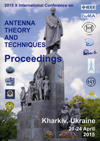NenuFAR : Instrument description and science case
DOI:
https://doi.org/10.1109/ICATT.2015.7136773Keywords:
radio astronomy, radio telescope, antenna array, antenna effective areaAbstract
NenuFAR is both a giant extension of the LOFAR and a large standalone instrument in the low-frequency range (10-85 MHz). It was designed in Nançay with national and international collaboration. Antenna radiators were modeled on the LWA antenna design whereas preamplifiers were designed in France. Antennas will be distributed in 96 mini-arrays of 19 dual-polarized elements, densely covering a disk of 400 m in diameter. A few mini-arrays are expected to lie at distances of 2-3 km. A silent control-command system was designed, and the computer dialog with LOFAR defined. Receivers will include the LOFAR backend, a local beamformer and a local correlator. NenuFAR is in construction in Nançay and it was recently granted by the SKA office the official label of SKA pathfinder. Its exploitation will expand the scope of LOFAR scientific studies as well as permit new studies, preparing for SKA science. The NenuFAR concept has many points in common with GURT (the Giant Ukrainian Radio Telescope), with which it shares some technical studies, an its exploitation will benefit from a coordination with UTR-2. We describe the instrument, technical developments and science case.References
VAN HAARLEM, M.P.; WISE, M.W.; GUNST, A.W. LOFAR: The Low Frequency ARray, Astron. and Astrophys, 2013, v.556, doi: http://dx.doi.org/10.1051/0004-6361/201220873.
GIRARD, J.N.; ZARKA, P.; TAGGER, M.; RUCKER, H.O. Planetary Radio Emissions VII. Austrian Acad. Sci. Press, 2011, p.495-503, doi: http://dx.doi.org/10.1553/PRE7s495.
GIRARD, J.N.; ZARKA, P.; TAGGER, M. Antenna design and distribution of the LOFAR Super Station, C. R. Phys., 2012, v.13, p.33-37, doi: http://dx.doi.org/10.1016/j.crhy.2011.11.004.
BOONE, F. Interferometric array design: Optimizing the locations of the antenna pads, Astron. and Astrophys, 2001, v.377, p.368-376, doi: http://dx.doi.org/10.1051/0004-6361:20011105.
VASKO, F.J.; BARBIERI, R.S.; RIEKSTS, B.Q.; REIT-MEYER, K.L.; STOTT, K.L. The cable trench problem: combining the shortest path and minimum spanning tree problems, Computers and Operations Res., 2002, v.29, p.441-458, doi: http://dx.doi.org/10.1016/S0305-0548(00)00083-6.
SERYLAK, M.; KARASTERGIOU, A.; WILLIAMS, C. Observations of Transients and Pulsars with LOFAR International Stations, Proc. of Conf. on Electromagnetic Radiation from Pulsars and Magnetars, pp.83-86.
ARMOUR, W.; KARASTERGIOU, A.; GILES, M.; BALLESTER, P.; EGRET, D. A GPU-based Survey for Millisecond Radio Transients Using ARTEMIS, Proc. of ADASS XXI, p.33-37.
PRASAD, P.; WIJNHOLDS, S.J. AART-FAAC: Towards a 24x7, All-sky Monitor for LO-FAR, Proc. of New Windows on Transients across the Universe.

